The Book of Hours and Our Lady
The Book of Hours and Our Lady
– Father Johann Roten, S.M.
Description
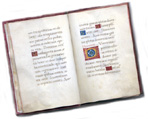
The Books of Hours were the prayer books used by laypeople in medieval times. Commissioned by royal family members, the nobility and wealthy patrons, they became status symbols, the jewels in the collections of book collectors.
The Divine Office
The Book of Hours is modeled on the Divine Office recited by members of the clergy. The Office is divided into seven periods of the day, called hours: Matins and Lauds (the night hours recited together between midnight and dawn) the day hours, recited at approximately three-hour intervals: Prime, Tierce, Sext and None, and the evening hours of Vespers and Compline.
The Little Office of Our Lady
The Divine Office consists chiefly in the recitation of the Psalms, but it also includes hymns and prayers of various kinds.
Additional devotions were added in the course of time. Among these additions was a service honoring the Blessed Virgin. This first appeared sometime in the tenth century. This Little Office of Our Lady became the basic text of what eventually became the Book of Hours. Its recitation spread from the religious orders to the secular clergy and from them to the laity. Until the thirteenth century the Little Office formed a kind of appendix to the Psalter, the prayer book normally used by the laity. Sometime during the thirteenth century it became detached and became a separate book: the Book of Hours.
Contents of the Books of Hours
The basic components of the Book of Hours are:
![]()
1. Calendar
2. Extracts from the Gospels
3. The prayer Obsecro
4. The Prayer O intemerata
5. Hours of the Virgin
6. Hours of the Cross
7. Hours of the Holy Spirit
8. Penitential Psalms
9. Litany
10. Office of the Dead
11. Prayers to Various Saints
The Calendar, Hours of the Virgin, the Penitential Psalms, Litany, Office of the Dead, and Prayers to the Saints were taken from the books used by the clergy. The other parts listed here are secondary texts. To these were added a variety of other prayers. The result of all this: no two Books of Hours are exactly alike.
Decorations and Illustrations

Illumination is the word used to designate the decorations found in Books of Hours. The basic elements in illumination area the initial, the miniature and the border.
The word miniature does not refer to the small size of the pictures found in these books. It comes from the Latin minium, the red pigment (lead oxide) used by scribes to emphasize initial letters or important words in a text. Miniare meant to write in vermilion. The word miniature was later extended to include illustrations of whatever kind.
Initials were of two kinds: the decorative were filled with interlacings of various kinds (abstract ornaments, foliage, etc). Historiated initials are those in which small pictures (ystoires) appear. These may be portraits or scenes that illustrate the text.
The third element is the border which surrounds the miniature and often the whole page of text. Elaborate borders of ivy leaves were very characteristic of the Books of Hours produced in northern Europe, France particularly.
Calendar Decorations
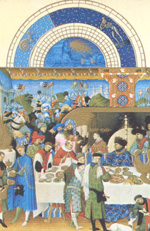
January - Feasting
February - Sitting by the Fire
March - Pruning Vines
April - Garden Scene
May - Hawking or Boating
June - The Hay Harvest
July - Reaping the Wheat
August - Threshing
September - Harvesting Grapes
October - Ploughing and Sowing
November - Gathering Acorns for Pigs
December - Killing the Pig or Baking Bread
Signs of the Zodiac are often found as secondary illustrations in calendars.
Miniatures Illustrating the Hours of the Virgin
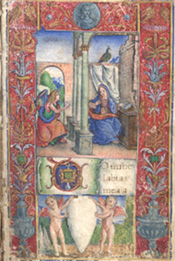
Matins - Annunciation
Lauds - The Visitation
Prime - The Nativity of Jesus
Tierce - The Angel's Announcement to the Shepherds
Sext - The Adoration of the Magi
None - The Presentation in the Temple
Vespers - The Flight to Egypt and/or the Slaughter of the Innocents
Compline - The Coronation of Mary
Miniatures Illustrating the Hours of the Passion

Matins - The Betrayal by Judas
Lauds - Christ Before Pilate
Prime - The Scourging
Tierce - Christ Carries the Cross
Sext - The Crucifixion
None - Taking Down from the Cross
Vespers - The Burial of Jesus
Compline - the Resurrection
Examples of Some Famous Books of Hours
1. THE DE BRAILES HOURS
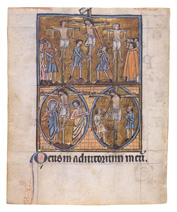
The earliest surviving separate Book of Hours. Produced around 1240 in Oxford, England, by William de Brailes for a laywoman named Susanna. The book of 101 leaves (202 pages) contains the Hours of the Virgin, the Penitential Psalms, the prayers (suffrages) addressed to the saints, the Litany, collects, the Gradual Psalms. The book was purchased by the English book collector C.W. Dyson Perrins from the firm of J. Rosenthal in Munich in 1906. Since 1959 it has been in the British Library of London.
2. HOURS OF JEANNE D'EVREUX
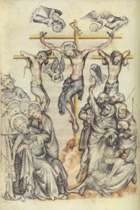
Jeanne d'Evreux (1304-1371) was the third wife of Charles IV (1295-1328). The Book of Hours may be a wedding gift from her husband (1325). The illuminations are the work of Jean Pucelle (d. 1334), who transformed book illumination in Paris of the fourteenth century. His work reflects strong Italianate influences. A special feature of the book is the office honoring St. Louis IX (1214-1270), who died during his second crusade. He was canonized in 1297. St. Louis was the great-grandfather of both Jeanne and her husband Charles IV. Jeanne willed her book to Charles V, who then gave it to his brother Jean, the Duc de Berry. Sometime in the ninteenth century the book was acquired by the Rothschild family. In 1953 it was purchased by the Metropolitan Museum of New York. It is now part of the collection at the Cloisters Museum of that city.
3. THE GRANDES HEURES
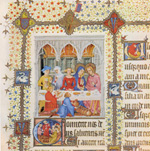
THE GRANDES HEURES of Jean, duc de Berry (1340-1516). Third son of John II (1319-1364), who is called John the Good. The Duke of Berry was one of the wealthiest patrons of all times. Of his seventeen castles only a few ruins remain. His jewels are all gone. Gold and silver objects were melted down to help pay his debts and also to finance the wars against the English. Of his three hundred manuscripts (so estimated) about a third remain, ninty-three illuminated. The Books of Hours are perhaps the most esteemed of these. THE GRANDES HEURES is the largest Book of Hours ever made. Someone had the job of finding the animal skins for its 126 leaves. The decorations appear to be the work of several artists and incorporated features found in other books that the Duke owned. The grotesques that appear in the margins are often copies of adaptations of those found in the Hours of Jeanne d'Evreux. The book was greatly prized by the kings of France. Charles VIII had it rebound in 1488. It is now in the Bibliotheque Nationale of Paris.
4. THE BELLES HEURES
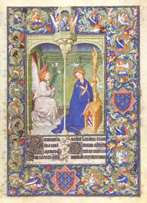
THE BELLES HEURES of Jean, Duke of Berry. Work of the Limbourg brothers (Paul, Jean and Herman), the most accomplished of the artists in the Duke's employ. Dated 1408-1410. The 225 leaves contain ninty-four full-page miniatures, fifty-four column illustrations, initials and borders. An unusual feature of the book are picture cycles giving the stories of St. Catherine of Alexandria, St. Bruno (founder of the Carthusians), St. Jerome, St. Anthony Abbot and John the Baptist (the Duke's patron saint), etc. At the Duke's death in 1416, it was acquired by his niece, Yolande, Duchess of Anjou. Edmond de Rothschild bought it from the Ailly family in 1880. In 1954, is was acquried by the Cloisters Collection from Maurice de Rothschild.
5. THE TRES-RICHES HEURES
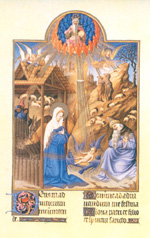
THE TRES-RICHES HEURES of the Duke de Berry. Recognized as the masterpiece of the Limbourg Brothers who worked on it between 1411 and 1416 when death overtook them. Other French illuminators were acquainted with the book in the decades of 1416. Various details were copied or adapted by them. Duke Charles I of Savoy and his wife, Blanche of Montferrat, both descendants of the Duke through his daughter Bonne, acquired the book near the end of the fifteenth century. They commissioned Jean Colombe of Bourges to complete the decoration. The work was done between 1485 and 1490. The last owner of the Tres Riches Heures was the Duke of Aumale, youngest son of the French King, Louis-Philippe. He acquired it in 1855 from the Baron Felix de Margherita of Turin and Milan. It is now part of the collection at the castle of Chantilly, which the Duke of Aumale created in an area north of Paris.
6. THE HOURS OF MARY OF BURGUNDY
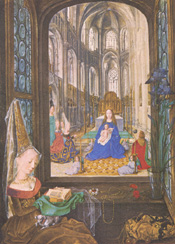
THE HOURS OF MARY OF BURGUNDY date from around 1477. Mary was the only child of the last Duke of Burgundy, Charles the Rash (1433-1477) who died in January of 1477 at Nancy, battling the Swiss. Born in 1457, Mary married the Hapsburg Archduke Maximillian of Austria a few months after her father's death. She died in 1482 (after a hunting accident). She left two children, Margaret and a son Philip, who also died young but not before he had become father to the future Emperor Charles V. Mary was then ancestress to many Hapsburgs. She and her father Charles are buried side by side in a chapel of the Cathedral of Bruges, Belgium. There is no agreement among the experts as to who the artist or artists responsible for the decoration of Mary's Book of Hours happened to be. Now in Vienna's Osterreichische Nationalbibliothek.
7. THE GRANDES HEURES OF ANNE OF BRITTANY.
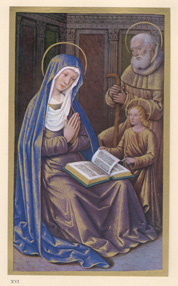
THE GRANDES HEURES OF ANNE OF BRITTANY. Anne (1477-1514) was twice Queen of France, first in 1491 to Charles VIII (1470-1498) and then in 1499 to Louis XII (1461-1515). Her Book of Hours was decorated by Jean Bourdichon.
8. THE GRANDES HEURES DE ROHAN
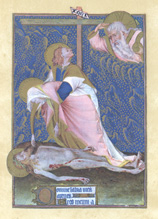
THE GRANDES HEURES DE ROHAN date from around 1420. The unknown artist is simply referred to as the Rohan Master. He appears acquainted with the work of the Limbourg Brothers and with the Boucicault and Bedford Masters. The book was most probably made for Yolanda of Aragon (1380-1443), widow of Louis II, Duke of Anjou (1377-1417). The book is now in the Bibliotheque National of Paris.
9. THE HOURS OF GIANGALEAZZO VISCONTI
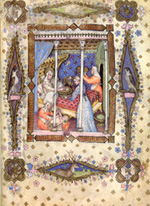
Duke of Milan. Giangaleazzo (1351-1402) overthrew his uncle Bernabo in 1378 and proceeded to extend his rule by a series of brilliant military campaigns. Around 1388 he commissioned Giovannino dei Grassi, an architect and painter to produce a Book of Hours. Dei Grassi was already employed in building the new cathedral of Milan and the Carthusian Monastaery in Pavia, both of which Giangaleazzo had also commissioned. The artist died in 1398 after finishing the decoration of nearly half the written pages. This was bound separately. Giangaleazzo's son, Filippo Maria entrusted the decoration of the remaining pages to Belbello of Pavia around 1428, at the time of his marriage to Maria of Savoy. Both artist show a keen interest in animals and birds. The pages by Belbello contain a cycle of Old Testament scenes, an unusual feature in a Book of Hours. Both sections of the book are now in Florence's Biblioteca Nazionale since 1959.
10. THE HOURS OF CARDINAL ALESSANDRO FARNESE
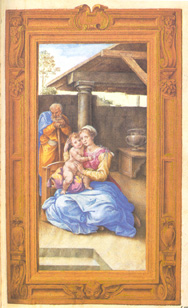
THE HOURS OF CARDINAL ALESSANDRO FARNESE were completed in 1546. The work of Giulio Clovio (born Juraij Glovicic in Croatia in 1498). He died in the service of Cardinal Farnese in 1578. The text was written by Francesco Monterchi, secretary to Pier Luigi Farnese, Cardinal Allessandro's father. The script is known as the chancery hand, much easier to read than the heavy crowded gothic lettering of the other books we have seen.
All About Mary includes a variety of content, much of which reflects the expertise, interpretations and opinions of the individual authors and not necessarily of the Marian Library or the University of Dayton. Please share feedback or suggestions with marianlibrary@udayton.edu.
